
Ten Unforgettable Examples of Abstract Drawing
Drawing is one of the simplest and most accessible ways to make in art. Almost anyone can do it. All it takes is a writing implement and a flat surface. Yet as simple as the medium can be, some of the most unforgettable abstract artworks are abstract drawings. Sometimes abstract art can be divisive. It is inherently ambiguous and invites a certain amount of conjecture. For many people that ambiguity is charming, because it allows for the unfettered participation of anyone willing to open up to a work of art. But for others the pressure of trying to “get” or “figure out” a work of abstract art is a turn off. Abstract drawings somehow assuage a bit of that pressure. They are approachable and direct. They use a limited range of mediums, and their tendency is to be small in scale. Also, to sit down with a pencil and paper is the most natural thing in the world. There are no expectations. Very little money has been spent on the materials. An artist can draw dozens of drawings and throw them all away with barely any loss of resources. That fact could be partially responsible for why so many iconic abstract drawings are done by artists that usually work in other mediums; because in their least guarded moments they casually drew something that expressed the truest nature of their ideas from deep within.
Defining Abstract Drawings
The word drawing has developed sort of a loose definition over the last century or so. There was a time when a drawing was defined as an image made on a two-dimensional surface with a pen, pencil or crayon. But over the past century, several innovative artists have managed to expand that definition. Alexander Calder referred to his wire sculptures as drawings in space. Sol LeWitt made drawings by creating rips in a sheet of paper; the rips were representative of drawn lines. Palestinian-born British artist Mona Hatoum makes drawings by affixing human hairs in abstract patterns on handmade paper. And many artists like Paul Klee combine the act of drawing with other mediums like painting and collage.
Even though the definition of drawing has expanded far beyond its original definition, for our list of unforgettable abstract drawings we have attempted to limit our choices to works that are representative of the simplest possible approach to the act of drawing. Most of our choices are on paper and made with graphite or ink, and were made intentionally as finished artworks. But some represent preliminary sketches for other works of art, some finished and some not, or were made to work out the details of an idea. Many artists turn to drawing in order to express some essential concept they are struggling with, and suddenly a form, a gesture or a composition emerges that perfectly expresses the essence of their search. A couple such examples appear on our list. So with no further ado, here is our list of ten abstract drawings that we find unforgettable.
Ulrike Müller - Curiosity 1
Austrian-born Ulrike Müller is an influential voice in contemporary abstract art. She engages with a diverse range of tendencies in her studio practice, one of which is drawing. Her oeuvre addresses relationships, including those between individuals and groups, as well as those between forms and symbols. The drawing we chose by Müller is part of a larger series of work that explores multiple forms and compositional variations related to gender and sexuality. This drawing stands out to us as iconic of the overall lexicon of the series, while also standing on its own as a transcendent abstract image. It possesses a range of possible interpretations, and embraces the specific qualities of its medium.
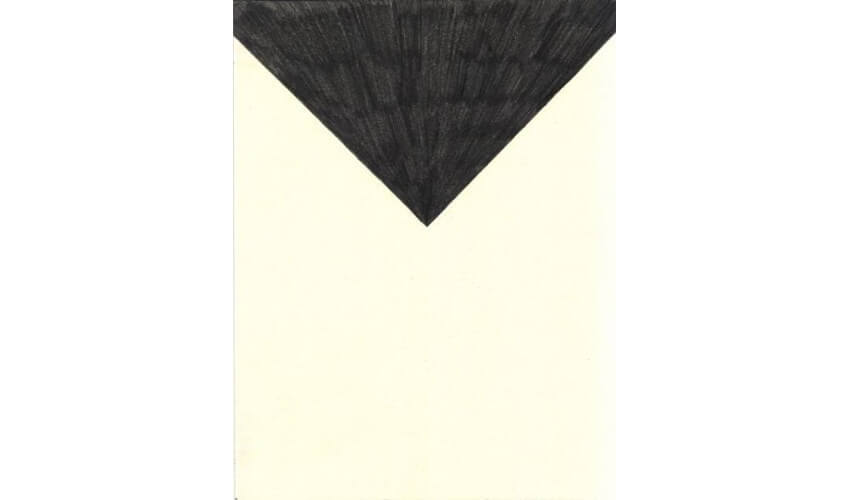 Ulrike Muller - Curiosity 1, 2005-2006. Pencil and spray paint on 51 sheets of paper. Each: 11 × 8 1/2" (27.9 × 21.6 cm). Acquired through the generosity of The Contemporary Arts Council of The Museum of Modern Art. MoMA Collection
Ulrike Muller - Curiosity 1, 2005-2006. Pencil and spray paint on 51 sheets of paper. Each: 11 × 8 1/2" (27.9 × 21.6 cm). Acquired through the generosity of The Contemporary Arts Council of The Museum of Modern Art. MoMA Collection
Richard Tuttle - Blue/Red, Phase: Drawings #4
The Post-Minimalist artist Richard Tuttle has a reputation for making simple, elegant artworks that express universalities in the most direct way possible. The influence of his personality and his hand are evident in his works. His oeuvre extends from paintings to sculptures to installations and drawings. Some of his most iconic works involve the simplest materials and most delicate actions, for example shaping a thin strand of wire and hanging it on a wall under direct light, simply interplaying its form with its shadow. This simple drawing we have chosen by Tuttle beautifully and powerfully expresses both the simplicity and the idiosyncratic personality communicated by his oeuvre.
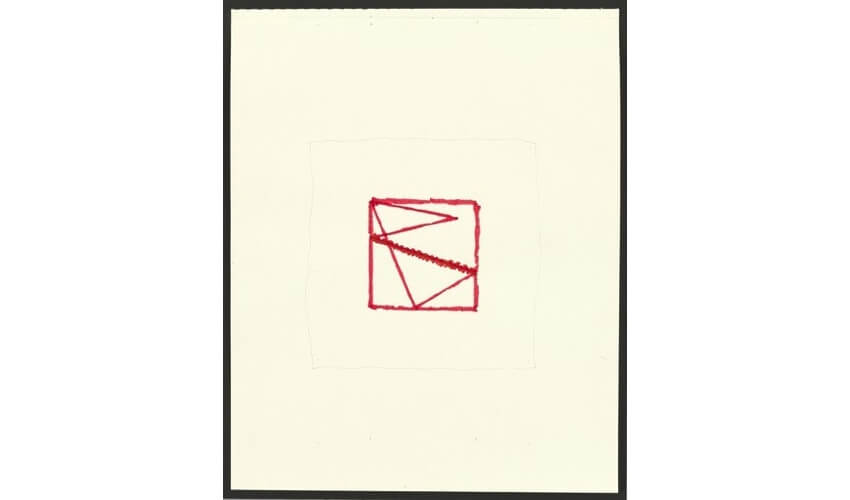 Richard Tuttle - Blue-Red, Phase, Drawings #4, Gouache, felt-tip pen, and pencil on paper in artist's frame. 15 x 12 1/4 x 1 1/2" (38.1 x 31.1 x 3.8 cm). The Judith Rothschild Foundation Contemporary Drawings Collection Gift. MoMA Collection. © 2019 Richard Tuttle
Richard Tuttle - Blue-Red, Phase, Drawings #4, Gouache, felt-tip pen, and pencil on paper in artist's frame. 15 x 12 1/4 x 1 1/2" (38.1 x 31.1 x 3.8 cm). The Judith Rothschild Foundation Contemporary Drawings Collection Gift. MoMA Collection. © 2019 Richard Tuttle
Donald Judd - Untitled (Pencil Drawing on Yellow Paper)
Donald Judd is perhaps best known for his thoughtful and intelligent essay titled Specific Objects, which addressed many of the philosophical concerns held dear by the artists associated with Minimalism. We chose this drawing by Judd for perhaps a rather subversive reason. His work was strictly unemotional. It utilized industrial materials and processes and avoided references to the personality or physicality of the artist. This drawing, carefully handmade with a simple, ancient medium on paper, and full of slight imperfections, betrays many of the ideals Judd held most dear. Nonetheless, somehow the intense color of the manufactured still speaks in conversation with his most memorable works.
 Donald Judd - Untitled (Pencil on colored paper). 1976. 14 1/2 x 17 1/8" (36.8 x 43.5 cm). Gift of Sarah-Ann and Werner H. Kramarsky. MoMA Collection. © 2019 Judd Foundation / Artists Rights Society (ARS), New York
Donald Judd - Untitled (Pencil on colored paper). 1976. 14 1/2 x 17 1/8" (36.8 x 43.5 cm). Gift of Sarah-Ann and Werner H. Kramarsky. MoMA Collection. © 2019 Judd Foundation / Artists Rights Society (ARS), New York
Dorothea Rockburne - Drawing Which Makes Itself
Dorothea Rockburne has referred to drawing as, “the bones of thought.” In the 1970s she offered a unique aesthetic proposition through her experimentation with inexpensive materials, personal, intimate processes and the simplest of gestures. Her folded paper works, on which she traced along the folds, are both subtle and profound. We chose this drawing because of the way it presents expressive geometric patterns with the simplest of methods, through pressure exerted on carbon paper. It offers an iconic peek at her beautiful mind.
 Dorothea Rockburne - Drawing Which Makes Itself, Carbon, carbon transfer, and pencil on paper, 22 1/2 x 30 in, 1972. © 2019 Dorothea Rockburne / Artists Rights Society (ARS), New York
Dorothea Rockburne - Drawing Which Makes Itself, Carbon, carbon transfer, and pencil on paper, 22 1/2 x 30 in, 1972. © 2019 Dorothea Rockburne / Artists Rights Society (ARS), New York
Robert Smithson - Untitled (Three Spiral Jetty Drawings)
Earlier this year we had the chance to travel in person to see Spiral Jetty, the seminal work of land art created by Robert Smithson in the bed of the Great Salt Lake in Utah. The trip to the site can be brutal, a 10-mile slow drive over an unforgiving, pockmarked gravel road. And the artwork itself is difficult to take in, as it competes with the natural grandeur of its surroundings. This drawing, playfully created on graph paper, expresses the innocence and universality of Spiral Jetty, and is memorable for the way it helps us to contextualize the overall experience of the work.
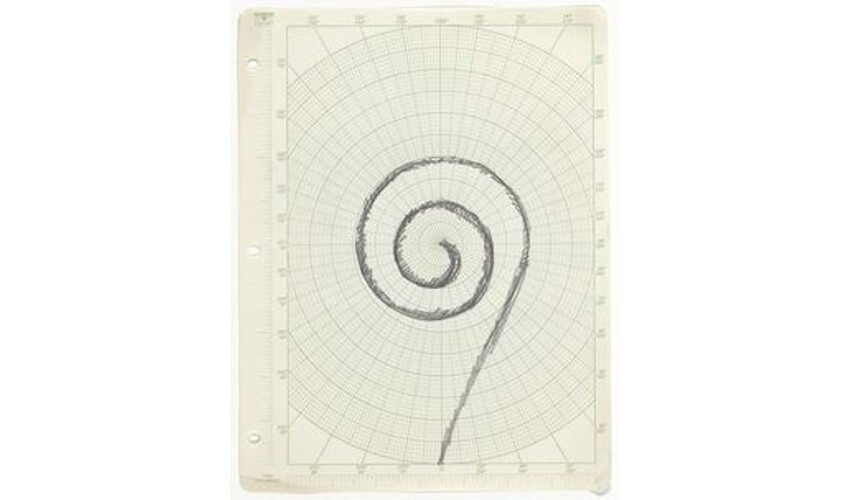 Robert Smithson - Untitled (Three Spiral Jetty Drawings), c. 1970. Pencil on three sheets of graph paper. 11 x 8 1/2" (27.9 x 21.6 cm) (each). Fractional and promised gift of Tony Ganz in memory of Victor and Sally Ganz. MoMA Collection
Robert Smithson - Untitled (Three Spiral Jetty Drawings), c. 1970. Pencil on three sheets of graph paper. 11 x 8 1/2" (27.9 x 21.6 cm) (each). Fractional and promised gift of Tony Ganz in memory of Victor and Sally Ganz. MoMA Collection
Georgia O'Keeffe - Drawing X
Georgia O’Keefe began her career by sending off a series of charcoal drawings to a friend just to get her point of view on them. That friend took the drawings to the gallery of Alfred Stieglitz in New York City. Stieglitz was a massive influence on the Modernist art scene, and he called the drawings the “purest, finest, sincerest things” he had seen in a long time. O’Keefe made this drawing four decades later. Like much of her work, it could be read as evocative of a natural form, like the curve of a tree branch, or it could be read as totally abstract. We adore it for the mastery of the medium it shows, and for its effortless simplicity.
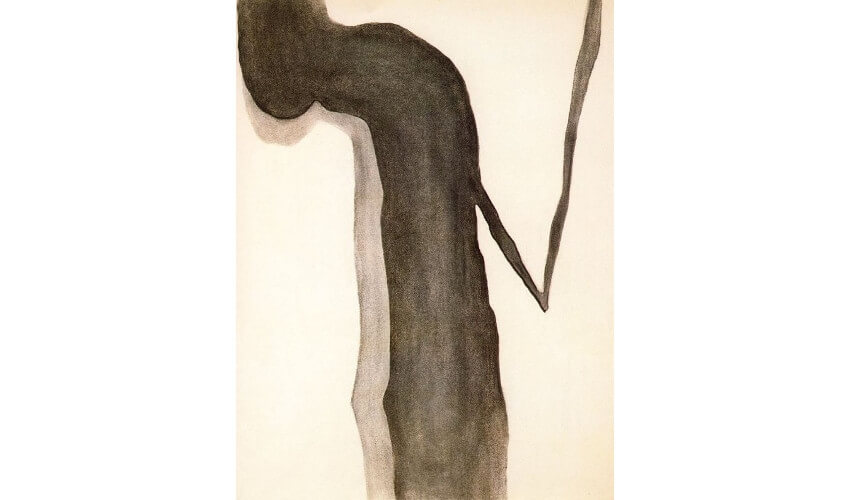 Georgia O'Keeffe - Drawing X, 1979. Charcoal on paper. 24 7/8 x 18 5/8 in. © 2019 The Georgia O'Keeffe Foundation / Artists Rights Society (ARS), New York
Georgia O'Keeffe - Drawing X, 1979. Charcoal on paper. 24 7/8 x 18 5/8 in. © 2019 The Georgia O'Keeffe Foundation / Artists Rights Society (ARS), New York
Rachel Whiteread - 24 Switches both on and off
The contemporary artist Rachel Whiteread has had a distinguished start to her career. She was considered one of the Young British Artists, and became the first female Turner Prize winner in 1993. Whiteread is primarily known for her sculptural oeuvre, which consists of casts of objects and structures of various sizes. She has also been known to create monumental site-specific installations. Drawing is not a major part of her practice. She uses drawings, she says, as a way to “choreograph a space.” We chose this drawing for its qualities as an artwork in its own right. In a sense it could potentially help re-contextualize a three-dimensional work, but we chose it for the purity and elegance it exudes as a unique abstract aesthetic expression.
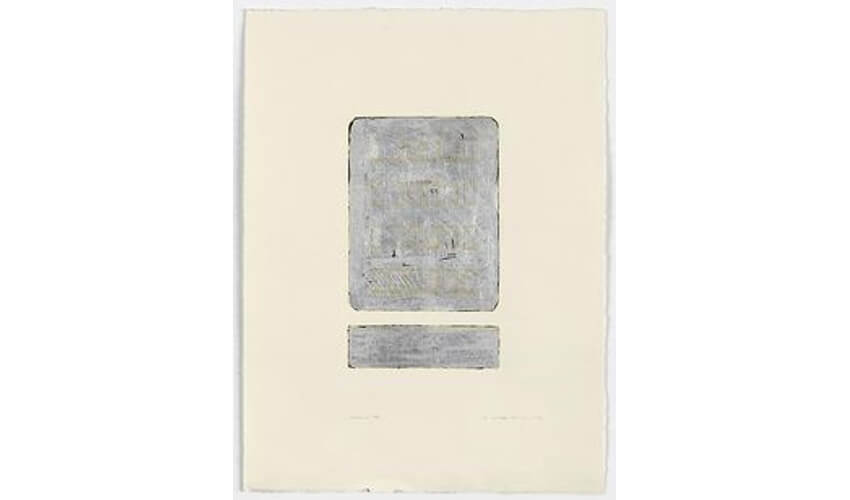 Rachel Whiteread - 24 Switches both on and off, 1998. Silver leaf and yellow ink on paper. 26 1/4 x 19 ½ in. Committee on Drawings Funds. MoMA Collection. © 2019 Rachel Whiteread
Rachel Whiteread - 24 Switches both on and off, 1998. Silver leaf and yellow ink on paper. 26 1/4 x 19 ½ in. Committee on Drawings Funds. MoMA Collection. © 2019 Rachel Whiteread
Elaine de Kooning - Unused preparatory drawing from In Memory of My Feelings
Frank O'Hara was a renowned poet, and a former Associate Curator of Painting and Sculpture at the New York MoMA. He died in 1966. The following year the museum released a book and an accompanying exhibition in his honor. The book contained sixty drawings by 30 American artists, including the biggest names in Mid-Century abstraction. We chose this unused submission from Elaine de Kooning. Though other drawings by de Kooning were used in the book, we find an inimitable ephemeral quality to this drawing that is missing in the other accepted pieces. The grace of it, the immediacy of its gestures and the simplicity of its form conjure notions of an ancient, unknown alphabet full of emotion and depth.
 Elaine de Kooning - Unused preparatory drawing from In Memory of My Feelings, 1967. Ink on acetate. Sheet: 13 7/8 x 11" (35.3 x 27.9 cm). Gift of the artist. MoMA Collection
Elaine de Kooning - Unused preparatory drawing from In Memory of My Feelings, 1967. Ink on acetate. Sheet: 13 7/8 x 11" (35.3 x 27.9 cm). Gift of the artist. MoMA Collection
Kazimir Malevich - Suprematist Drawing
In 1915, Kazimir Malevich revolutionized abstraction with the creation of his iconic art style known as Suprematism. Personified by his iconic painting Black Square, this bold new visual language was, and still remains for many, the ultimate expression of purity and universality. Malevich often drew out sketches of his ideas for paintings. We chose this particular drawing for its whimsy and the movement it seems to capture, as well as for the playful, casual imperfection it projects.
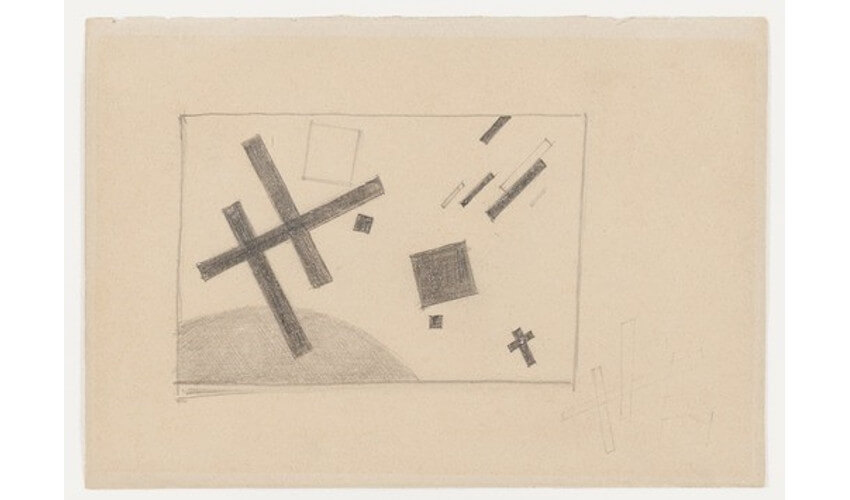 Kazimir Malevich - Suprematist Drawing, 1916-1917
Kazimir Malevich - Suprematist Drawing, 1916-1917
Ellsworth Kelly - One Stroke
The biomorphic abstract artworks of Ellsworth Kelly are often inspired by natural forms such as leaves or pieces of fruit. He often began the process of a larger work by sketching and drawing the forms that he saw in a garden or a park. This drawing could be read as a leaf, and it definitely speaks in conversation with a multitude of other drawings that contain similar forms. But it stands out from his other works. Its title speaks to the singularity of the unbroken line. The composition offers multiple readings, and organizes space into a contemplative, yet playful configuration.
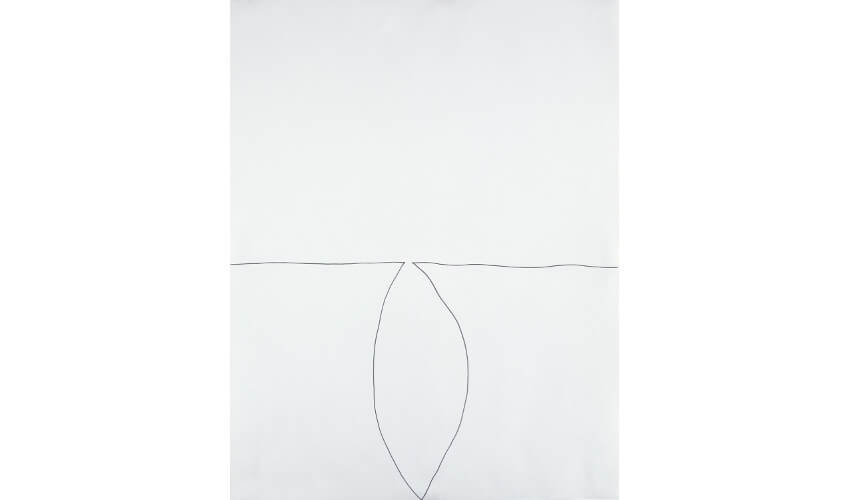 Ellsworth Kelly - One Stroke, 1962. Graphite on paper. 28 1/2 x 22 1/2 inches (72.4 x 57.2 cm). Solomon R. Guggenheim Museum, New York Purchased with funds contributed by Beatrice and Silas H. Rhodes, 1969. © Ellsworth Kelly
Ellsworth Kelly - One Stroke, 1962. Graphite on paper. 28 1/2 x 22 1/2 inches (72.4 x 57.2 cm). Solomon R. Guggenheim Museum, New York Purchased with funds contributed by Beatrice and Silas H. Rhodes, 1969. © Ellsworth Kelly
Featured image: Georgia O Keeffe - Drawing X (detail), 1979. Charcoal on paper. 24 7/8 x 18 5/8 in. © 2019 The Georgia O'Keeffe Foundation / Artists Rights Society (ARS), New York
All images used for illustrative purposes only
By Phillip Barcio






